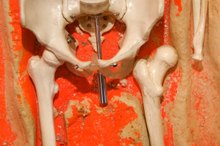What Exercises Can I Do So I Won't Tear During Labor?
The perineal muscles of your pelvic floor can weaken and become tense during pregnancy. A weak pelvic floor can contribute to tears and the need for an episiotomy, which is a surgical incision a doctor makes in the perineum to increase the vaginal opening and reduce tearing. Kegel and squatting exercises prepare perineal muscles of the pelvic floor for labor, reducing your risk of tearing during delivery 1. Get your doctor's approval for any exercise during pregnancy, and ask her for advice specific to your situation.
If you are experiencing serious medical symptoms, seek emergency treatment immediately.
Kegel Facts
Kegel exercises, named for their inventor, Dr. Arnold Kegel, strengthen and help you control pelvic floor muscles that support your uterus, urethra, bladder and bowel 1. Not only do these exercises reduce the risk of tears during labor, they can help prevent and treat urinary stress incontinence and hemorrhoids, two common pregnancy-related conditions, according to the BabyCenter website 14. Continuing to do kegel exercises postpartum improves your vaginal muscle tone and helps you maintain control of your bladder 1.
How To Do Kegels
Exercises for Round Ligament Pain
Learn More
Locate your pelvic floor muscles by contracting them as if to stop the flow of urine. Make sure you are not tensing abdominal, buttocks or leg muscles while doing kegels. Contract your pelvic floor muscles, which should give you a feeling of squeezing and lifting. Hold the contraction for 5 seconds, then relax for 5 seconds. As your muscles strengthen, hold each kegel for 10 seconds, then relax for 10 seconds. Do sets of 10 kegels three times daily.
- Locate your pelvic floor muscles by contracting them as if to stop the flow of urine.
- Contract your pelvic floor muscles, which should give you a feeling of squeezing and lifting.
Kegel Variations
When you are comfortable performing kegel exercises, try to do them in a variety of positions 1. For example, do kegels while lying down, sitting up, squatting and when you are down on all fours. You can also perform "wave" kegels. According to AskDrSears.com, the muscles of your pelvic floor are arranged in a three-looped figure-8 pattern, with loops around your urethra, vagina and anus. Try contracting these muscles from front to back, then releasing the muscles from back to front.
- When you are comfortable performing kegel exercises, try to do them in a variety of positions 1.
Squats
Exercises for a Retroverted Uterus
Learn More
Squatting widens pelvic openings and relaxes perineal muscles, reducing tearing during labor, according to AskDrSears.com. To perform squats, stand behind a sturdy chair and place both hands on its back for support. Contract your abdominal muscles while lifting your chest and relaxing your shoulders. Slowly lower your tailbone to the floor and stop midway between sitting and standing. Hold this position for 10 seconds, then take a deep breath and exhale as you rise from the squatting position. Do this exercise 10 times. As you become stronger, do 10 repetitions two or three times each day.
- Squatting widens pelvic openings and relaxes perineal muscles, reducing tearing during labor, according to AskDrSears.com.
- To perform squats, stand behind a sturdy chair and place both hands on its back for support.
Related Articles
References
Writer Bio
Jackie Carmichael has been a freelance writer for more than 10 years. Her work has appeared in "Woman's World" and "American Baby" magazines. Carmichael is a licensed registered nurse and has worked in fields related to cardiovascular health and psychiatry. She also holds a Bachelor of Arts in journalism from The Ohio State University.







